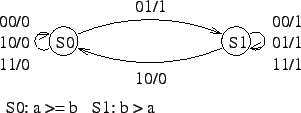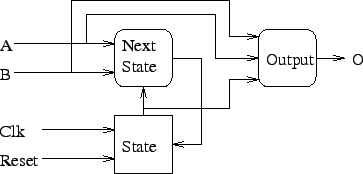Tom Kelliher, CS 240
Apr. 16, 2010
Collect assignment; discuss new assignment.
Wednesday's exam covers 4.1-5.2, including material covered in class on addition.
Read 7-1-3.
Sequential circuit design.
Registers
Notes:
library IEEE;
use IEEE.STD_LOGIC_1164.ALL;
use IEEE.STD_LOGIC_UNSIGNED.ALL;
entity flipFlop is
Port ( d : in std_logic;
reset : in std_logic;
clk : in std_logic;
q : out std_logic);
end flipFlop;
architecture Behavioral of flipFlop is
signal qInt : std_logic; -- Maintains FF state.
begin
q <= qInt; -- Drive FF output from internal state.
-- Trigger state process if clk OR reset changes.
state: process (clk, reset)
begin
-- Asynchronous active low reset.
if reset = '0' then
qInt <= '0';
-- Load new value on rising clock edge.
elsif clk'event and clk = '1' then
qInt <= d;
end if;
end process state;
end Behavioral;
Inputs: A, B, (no more msb). A and B are received least significant bit
first. Output 0 if ![]() , otherwise 1.
, otherwise 1.
Reset to S0 on reset.
State diagram:

Things to observe:
b <= a; c <= b;does not behave as it would in C.

Compare process inputs to sensitivity lists.
-- VHDL for serial comparator. The inputs a and b are input lsb first.
-- The Mealy machine uses rising edge sensitive flip-flops and an
-- asynchronous active low reset.
--
-- The output is 1 if b > a, otherwise 0.
library ieee;
use ieee.std_logic_1164.all;
entity comparator is
port
(a, b, clk, reset : in std_logic;
o : out std_logic
);
end comparator;
architecture process_defn of comparator is
-- Two states needed.
type state_type is (S0, S1);
-- State assignment.
attribute enum_encoding : string;
attribute enum_encoding of state_type :
type is "0 1";
signal state, next_state : state_type;
-- For convenience, concatenate a and b.
signal inputs : std_logic_vector (1 downto 0);
begin
-- Concurrent assignment executes the rhs changes.
-- Concatenate a and b into inputs.
inputs <= a & b;
-- Processes execute whenever something on their sensitivity list
-- changes. All assignments take place when the process exits.
--
-- This process implements the D flip-flop.
state_register : process (clk, reset)
begin
-- If/else construct only valid within a process.
if (reset = '0') then
state <= S0;
elsif (clk'event AND clk = '1') then
state <= next_state;
end if;
end process;
-- This process computes the next state.
next_state_process : process (inputs, state)
begin
case state is
when S0 =>
if (inputs = "01") then
next_state <= S1;
else
next_state <= S0;
end if;
when S1 =>
if (inputs = "10") then
next_state <= S0;
else
next_state <= S1;
end if;
end case;
end process;
-- This process computes the output.
output_process : process (inputs, state)
begin
case state is
when S0 =>
if (inputs = "01") then
o <= '1';
else
o <= '0';
end if;
when S1 =>
if (inputs = "10") then
o <= '0';
else
o <= '1';
end if;
end case;
end process;
end process_defn;